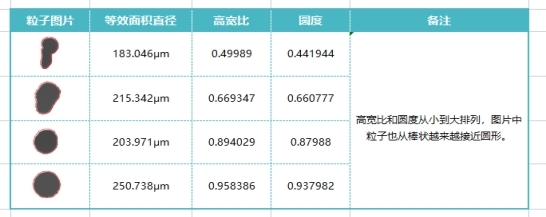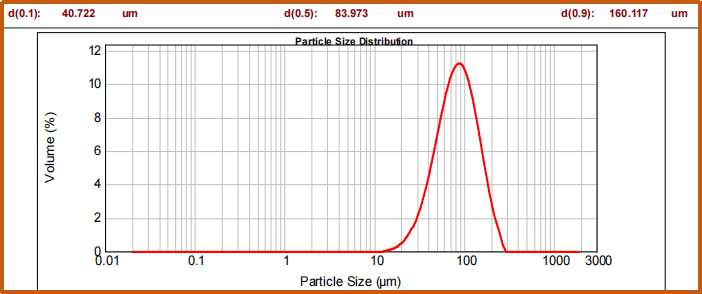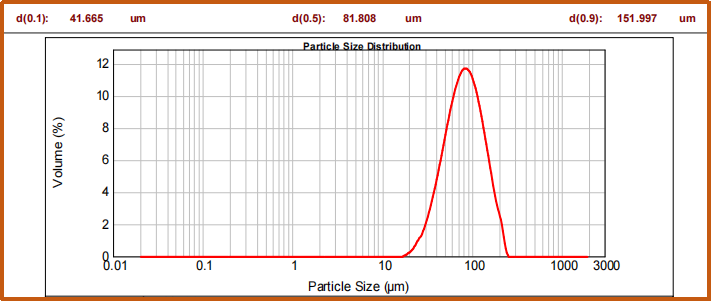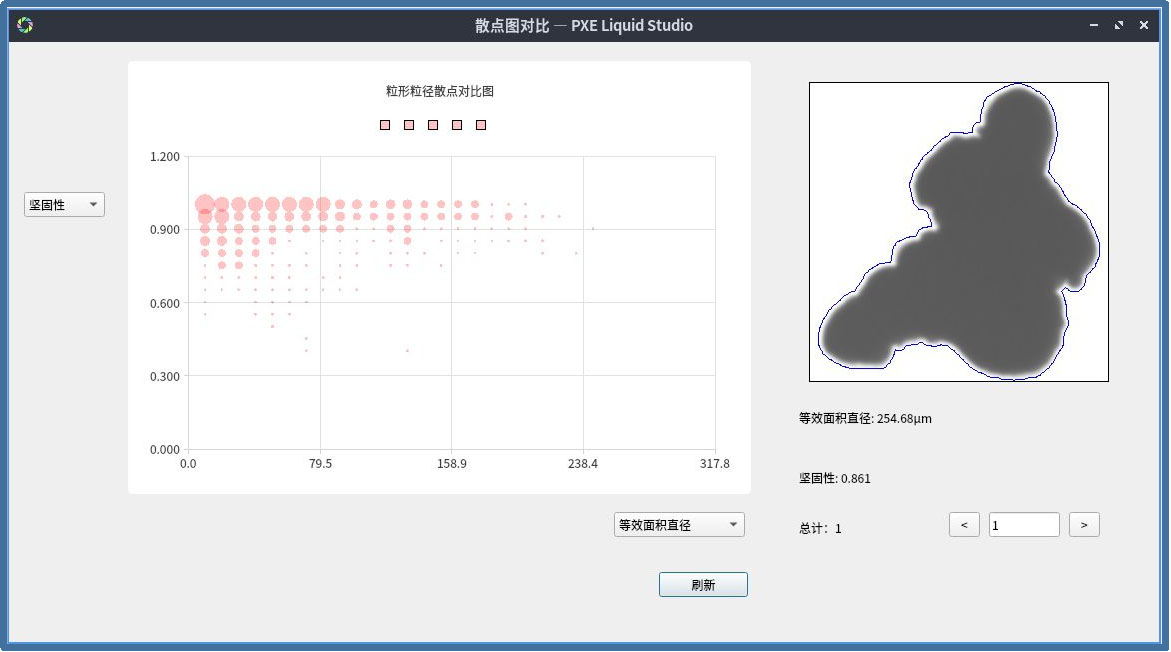
Catalyst is an indispensable part of chemical production. The size and shape of catalyst particles are important factors affecting the reaction effect and operating conditions. The catalyst with unfixed shape is easy to produce uneven distribution of air flow in use, which affects the efficiency. The regular shape of the catalyst can reduce the bed resistance, improve the surface area and shorten the diffusion path, and the shape of the catalyst must also obey the requirements of performance.
First:Principle of laser particle size analyzer
Many manufacturers use laser grameters to measure particle size. The principle is that when a light beam hits a particle, it will deviate from its original direction of propagation, which is described by the Michelson scattering theory based on Maxwell's electromagnetic wave theory. Under certain conditions, the larger the particle, the wider the distribution range of the scattered light. The thin laser beam from the laser is spatially filtered and collimated into a parallel, pure extended beam, which is then illuminated into the measuring chamber. The measured particles are dispersed and suspended in the dispersive medium in the pool. If the incident light encounters particles, it will be scattered, forming scattered light; Light that does not encounter a particle remains parallel, traveling in its original direction. The latter will converge to the center of the photodetector after passing through the Fourier lens, and pass through the hole in the center to be received by the central detector. After the scattered light passes through the Fourier lens, the light with the same scattering Angle is focused to the same point in the detector. So a point on the detector represents a scattering Angle theta. The detector consists of several independent detection units, each unit corresponds to a scattering Angle interval. The cell number increases from the center of the detector. The scattering Angle corresponding to the center of the detection unit and the receiving area of the unit increase exponentially with the increase of the serial number. The photoelectric signal output by each cell is proportional to the power of the scattered light projected onto the cell. The output signal of all units constitutes the scattered light energy distribution. Although the central bright spots of scattered light spots of particles of any size are strong in the center and weak in the edge, the peak of scattered light energy distribution is always located in a certain detection unit. The smaller the particle, the larger the scattered light spot, and the more outward the peak of the scattered light energy distribution.
Therefore, the laser particle size measurement is actually a virtual calculus from the value, and it can only measure the size, can not see the morphological characteristics. At the same time, the stability of the instrument and the configuration of optical path, the neutralization background of the instrument before measurement, sampling, sample dispersion, sample concentration, and the selection of optical characteristics parameters will affect the particle size results. For example, in the application of Mi's theory, three optical parameters need to be introduced, namely, the refractive index of the dispersion medium, the refractive index of the sample substance and the absorption rate of the sample substance. The smaller the particle, the greater the impact of the optical parameters on the results. Incorrect optical parameters will lead to wrong results. The reality is that many catalysts are not pure, the type and proportion of mixtures will affect the optical parameters, we can not accurately get these parameters, resulting in some deviation between the obtained results and the facts.
Second:Image method granularity analyzer principle
With the rapid development of optics and information science and technology, the latest image method, which combines the visual measurement method of image with statistics, can not only obtain the intuitive information of individual particles, but also obtain the statistical information of particle size and morphology of a large number of samples, so as to help users fully characterize the samples.
According to ISO 9276-1(or GB/T 15445.1), there are many definitions of particle size. The diameter of a sphere with the same physical characteristics, that is, the equivalent sphere diameter, is only an expression of one definition, and different definitions of particle size are related to the performance characteristics of a particle. Image analysis technology is a method to measure particle size, geometric shape and morphology, which can characterize all defined particle size and morphology parameters in one measurement. Execution standards for measurement, description and validation methods, including GB/T 21649.1 and ISO 13322-2.
Particle Shape is an enveloping surface composed of all points on its surface. morphology extends this simple shape description to complex descriptions, such as porosity, roughness and texture characteristics. Grain shape is the general term for particle shape and morphology.
Image analysis technology is a zooming microscopic imaging technology that directly measures particle size and morphology, and develops into a cutting-edge technology that quantifies a large number of particles to ensure statistical reliability of the final results of particle size and particle shape. Therefore, it is the latest generation of particle analysis technology, and will gradually replace the current popular laser particle size analysis technology.
The image analysis system provides a definite numerical distribution of grain shape parameters by quantifying the distribution values of various shapes rather than describing them qualitatively. At present, the most advanced particle shape analysis technology can provide more than 30 particle size distribution and particle shape distribution parameters, but also can count particles, which is equivalent to the integration of laser particle size meter, microscope and coulter counter function, is a new generation of technology to replace laser diffraction method. The sample particles were dispersed on slides on the sample table for still image analysis by autozoom microscanning photography. Instrument components include: particle dispersion area, particle measurement area, industrial digital cloud eye camera, aberration-free telecontrol lens, short-wavelength monochromatic light source, built-in vacuum pump and sample dispersion system, built-in computer and professional control and analysis software. The software can distinguish particles from the background, measure various particle size and particle shape parameters for each particle, and report the results.
Third: Case study and comparison
1、Single sample comparison
Sample source: Qingdao Huicheng Environmental Protection
Sample type: catalyst
Malvern 2000 report:

Report of R3000:

Figure 1: Equivalent area diameter

Figure 2: Scatter plot

Figure 3: Particle screening
From the comparison of the above reports, we can see that the R3000 report is more comprehensive, and this is only a small part of it. It can also tell the difference between particles on demand, and find exactly one type of particle.
For example, round and rod-like particles can be distinguished by comparing high width and roundness:

The adhesion of particles can be distinguished by comparing the satellite index:

2、Multiple sample comparison
Sample source: Qingdao Huicheng Environmental Protection
Sample type: catalyst
Report of the malvern 2000 :

图一:AIC-300

Figure 1: AIC-308
Report of R3000:

The test results of Malvern 2000 and R3000 both tell us that AI-300 and AI-308 are two samples with similar particle size distribution, and R3000 can also compare the test results of two samples together to more intuitively compare the difference in particle size distribution between two samples. In addition, the R3000 can also see the difference in large particle size between the two samples.

Figure 1: Scatter diagram of AI-300

Figure 2: AIC-300 particle screening

Figure 3: Scatter diagram of AI-308

Figure 4: AIC-308 particle screening
The performance of the catalyst is closely related to the basic physical properties of the powder, among which the shape, particle size and particle size distribution of the powder are extremely important.
The laser particle size analyzer can indeed measure the particle size and particle size distribution very well, but we can not know what is the situation of the larger particles measured, whether it is agglomeration or adhesion, which affects the improvement of the process. Usually, in the use of laser particle size instrument, will be equipped with electron microscopy to see the shape of the particle, we need to subjectively select the length diameter and short diameter equivalent of the particle to calculate the roundness and aspect ratio of the particle.
Then the image method analyzer can integrate the functions of the above two instruments into one, and optimize. Seeing is believing. While measuring the particle size distribution, we can also see the morphology of each particle. It is equipped with a powerful algorithm, can automatically calculate the particle size of each particle shape value such as: equivalent area diameter, roundness, bluntness, concave, crimp, irregularity and so on.
R-3000 is a highly innovative particle size and particle shape instrument. It adopts the testing method of static image analysis, combines advanced visual technology (aberration-free telocardiac lens and high resolution industrial camera to achieve high resolution particle image) with patented vacuum dispersion technology, which can be used in a relatively short time. Imaging analysis of tens of thousands of 0.3-3000μm particles to determine particle size and shape information, compared with the traditional laser particle size analyzer, microscope and electron microscope has a good advantage. Suitable for particle size and shape analysis of various dry powders.
· Innovative vacuum dispersion technology to achieve good dispersion of small to sub-micron samples
· Aberration-free telecentric lens with automatic magnification can be used to realize the switching of imaging with different magnification without lens conversion
· Static particle image analysis, consistent particle orientation, more accurate test results
· Automatic test path planning of scattered surface to avoid particle reshooting
· Ultra-high imaging resolution, realizing the testing of sub-micron particles, with the lower limit up to 0.3μm;
· Up to more than 30 kinds of particle size and shape parameters, which can realize a variety of filtering Settings, and can quickly classify particles
· All particles are automatically saved, and specific particles can be selectively exported
· Various statistical forms of data: bar chart, curve chart, scatter chart, etc., enabling horizontal comparison of parameters of the same type and correlation analysis of parameters of different types
· Test samples are 100% recyclable